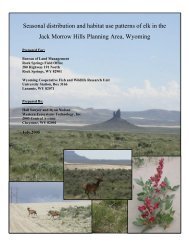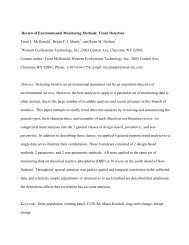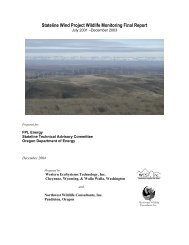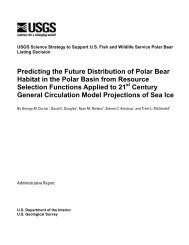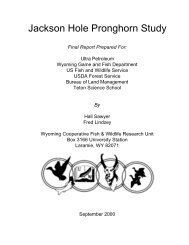baseline avian studies for the proposed maiden wind ... - WEST, Inc.
baseline avian studies for the proposed maiden wind ... - WEST, Inc.
baseline avian studies for the proposed maiden wind ... - WEST, Inc.
- No tags were found...
Create successful ePaper yourself
Turn your PDF publications into a flip-book with our unique Google optimized e-Paper software.
FINAL REPORTMAIDEN WIND PROJECT BASELINE AVIAN STUDIESTable 14. Vegetation types in <strong>the</strong> study area.Basic TypeVegetationTypeApprox.AcresPercent ofStudyAreaAgricultural Cropland 6419 35Riparian Riparian 135 1Steppe Shrub-steppe 4217 32General Habitat DescriptionCurrent croplands or recently abandoned cropland;potential to support wildlife variable depending onstage of crop or age since last tilled.Vegetation located along drainages; most drainagesare narrow and steep. Riparian vegetation includesan overstory of scattered chokecherry, goldencurrent, and/or red-osier dogwood, which providepotential habitat <strong>for</strong> nesting raptors when <strong>the</strong> treesare sufficiently large to provide nest plat<strong>for</strong>ms.Riparian areas with dense shrub/trees also providecover <strong>for</strong> big game and o<strong>the</strong>r wildlife.Big sagebrush or threetip sage is dominant with agrass/<strong>for</strong>b understory. The potential to supportwildlife varies depending on habitat quality (degreeof grazing/ weeds)Grasslandsteppe4114 31Predominantly grassland (native and non-nativegrass species), and may have scattered sagebrushpatches. Potential to support wildlife variesdepending on habitat quality (degree ofgrazing/weeds).Lithosolhabitat184 1Shallow-soiled habitat on ridgetops where nativebuckwheats and Sandberg’s bluegrass dominate.Potential to support wildlife varies depending onhabitat quality (degree of grazing/weeds).Rockoutcrop/shrub12




